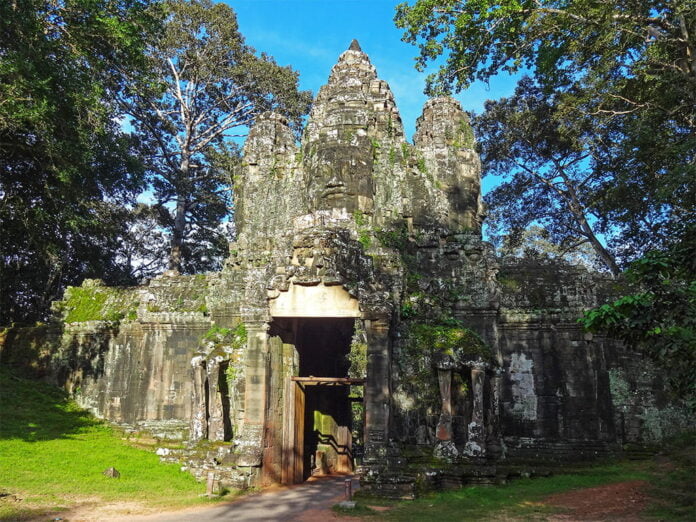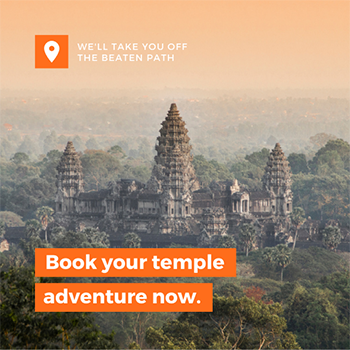An easy mistake made by many visitors to Cambodia, is that Angkor Thom is “another temple”. It’s not, it’s a whole city. “Angkor” means “city” and “Thom” means big – so the clue is in the name: Angkor Thom refers to what once was a great Khmer city and includes a whole host of temples and sites of historical interest.
5 facts about Angkor Thom
1. Angkor Thom site is 10sq km in size.
2. There are 216 faces on the Bayon temple.
3. Baphuon temple in Angkor Thom became one of the world’s largest jigsaw puzzles when the records from the carefully mapped pieces that had been taken apart were destroyed during the Khmer Rouge. Archaeologists were left with a lot of stones on the ground and only their best guess as to where they might all go.
4. Ta Prohm is not the only temple to feature in Tomb Raider. The east gate of Angkor Thom made an appearance as well.
5. The Angkor Thom gates would have originally been closed with wooden doors.
5 handy tips for visiting Angkor Thom
1. It is possible to walk around the whole Angkor Thom wall. There are a couple of steep scrambles to get up and down at the gates, but a walk round the wall is a lovely way to explore the Angkor Park.
2. The south west corner of the Angkor Thom wall, overlooking the moat, is a lovely sunset spot.
3. Don’t just visit Bayon. While the temple is fascinating, it’s really taking in all the other nearby structures that gives a sense of the scale of the site.
4. The south gate is the busiest with visitors as it is closest to Angkor Wat. For a magical entrance to the temples, buy you ticket first, and then hire a motodop to take you through the west gate of Angkor Thom to enter the temple park.
5. Angkor Thom is a big site and takes energy! Rehydrate with fresh coconuts sold in the local restaurants outside.
Angkor Thom’s history
Angkor Thom was founded by King Jayavarman VII, one of the most important figures of the Khmer Empire. He was a Buddhist, and during the time of his reign oversaw a wholesale conversion of the Khmer people from Hinduism to Buddhism. He was a great believer in public works, creating schools, hospitals, and reservoirs. He is also famous for resurrecting the Khmer Empire following Cham invasions, and creating a glorious new capital city – Angkor Thom – which was the central hub for a population of around 1 million.
Angkor Thom remained the capital of the Khmer Empire throughout its decline – and was probably fully abandoned in the 16th century. It is now, as with the other temples in the Angkor Park, a World Heritage site.
Architectural design
The city of Angkor Thom is surrounded by a wall, 8m high and 12km long, with five gates (two in the eastern wall). The entrances to some of the gates are lined with statues of gods and demons holding nagas, and the gates themselves are adorned with the face of Avalokiteshvara, the goddess of compassion (although it’s thought they also strangely resemble King Jayavarman VII). The wall itself is circled by a 100m wide moat. Bayon is in the center of this area, with Baphuon slightly to the west, and some of the smaller temples further north. The stunningly intricate Terrace of Elephants and Terrace of the Leper King are to the north of Bayon.
Bayon
Perhaps the spookiest or the most mesmerizing of the Angkor temples, the center piece of Angkor Thom – Bayon – looks like nothing much from a distance. However, once inside, you realize that Bayon is constructed around 54 towers, with 216 smiling faces of Avalokiteshvara peering down at you. Bayon is a fantastic temple to explore – with mazes of tunnels, blocked doorways and tumble-down rocks making it a perfect place to get lost in the mysteries of Angkor.
Bayon is 45m high and has three levels linked by stairs and small yards. The galleries on the first and second level have historical and religious bas-reliefs. The third level has a central circular tower, which is unique in Khmer Architecture.
Baphuon
Baphuon is located 200m west of Bayon and was marked as the center of the city when the whole of Angkor Thom was fully complete. A pyramidal representation of Mount Meru, at the time, it was probably one of the most impressive of the Angkor temples. A 200m elevated walkway leads to the temple which has a central tower 43m high.
Terrace of the Elephants
This 350m long terrace was supposedly used as a platform from which Jayavarman VII viewed his victorious returning army. The stairs are decorated with lions and garudas and life-sized images of elephants and their guardians are displayed on the terrace walls.
Terrace of the Leper King
This 7m high platform is located north of the Terrace of Elephants. On top of the platform you will see a nude statue (the original is kept in the National Museum of Phnom Penh). The exact meaning of the statue isn’t known. Some believe that it represents one of two possible Angkorian Kings who had leprosy. Others believe is represents the God of Death, and that the terrace as the royal crematory.
Preah Palilay
One of the loveliest temples in the Angkor Thom complex is Preah Paliliay in the north-west corner of the site. Quiet and atmospheric, it provides some great photo opportunities with huge trees looming over its structure.
Phimeanakas
Phimeanakas is more interesting historically than visually. It used to house a Royal Palace, where bathing would take place (the pools are still apparent) but very little remains. However, a climb up its pyramidal structure gives nice views of the surrounding area.



